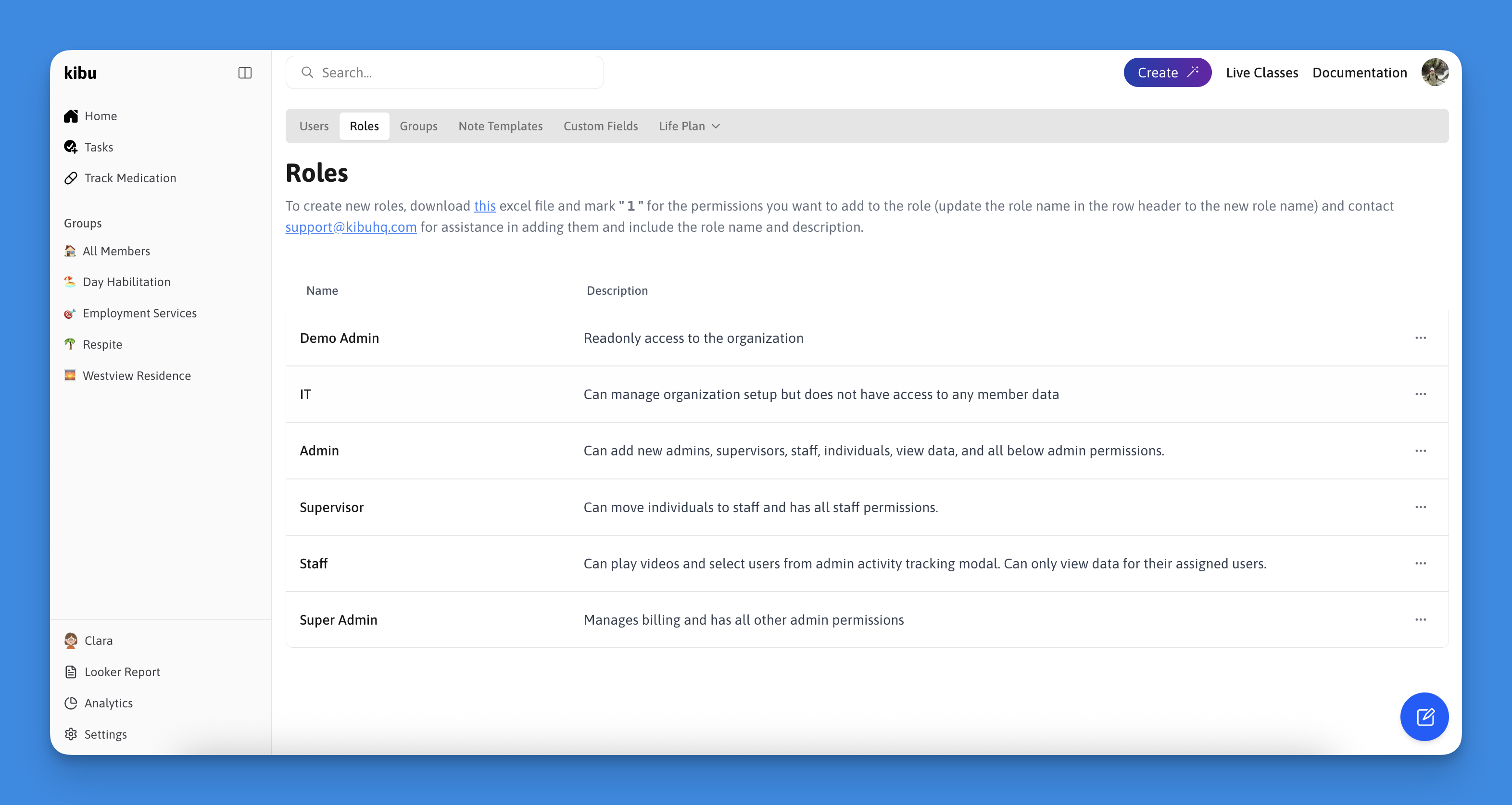Understanding Staff Roles

The Roles tab in settings has an easy to reference table to quickly view permissions
Quick Role Comparison
| Capability | Staff | Supervisor | Admin | Super Admin |
|---|---|---|---|---|
| Create service records & quick notes | ✓ | ✓ | ✓ | ✓ |
| Manage tasks | ✓ | ✓ | ✓ | |
| Manage groups and org settings | ✓ | ✓ | ||
| Full medical data access | ✓ | ✓ | ✓ | |
| Organization-wide read access | ✓ | |||
| Billing management | ✓ |
Detailed Permissions Matrix
Use this section when you need specifics. Expand a role to view its
resource-level capabilities. Columns indicate Create, Read, Update, Delete,
and Write.
Staff Role
Staff Role
| Resource | Create | Read | Update | Write |
|---|---|---|---|---|
| group-settings | ✓ | |||
| analytics | ✓ | |||
| admin | ✓ | |||
| member | ✓ | |||
| service-record | ✓ | ✓ | ✓ | |
| service-record-assignee | ✓ | |||
| service-record-attendance | ✓ | |||
| event | ✓ | ✓ | ✓ | |
| group-file | ✓ | ✓ | ✓ | |
| member-file | ✓ | ✓ | ✓ | |
| admin-file | ✓ | ✓ | ✓ | |
| life-plan | ✓ | |||
| quick-note | ✓ | ✓ | ||
| emergency-contact | ✓ | |||
| medical-history | ✓ | |||
| forms | ✓ | |||
| medication | ✓ | |||
| mar | ✓ | ✓ |
Supervisor Role
Supervisor Role
| Resource | Create | Read | Update | Delete | Write |
|---|---|---|---|---|---|
| group-settings | ✓ | ||||
| analytics | ✓ | ||||
| admin | ✓ | ||||
| member | ✓ | ||||
| service-record | ✓ | ✓ | ✓ | ✓ | |
| service-record-assignee | ✓ | ||||
| service-record-attendance | ✓ | ||||
| event | ✓ | ✓ | ✓ | ✓ | |
| group-file | ✓ | ✓ | ✓ | ✓ | |
| member-file | ✓ | ✓ | ✓ | ✓ | |
| admin-file | ✓ | ✓ | ✓ | ✓ | |
| life-plan | ✓ | ✓ | ✓ | ||
| quick-note | ✓ | ✓ | ✓ | ✓ | |
| emergency-contact | ✓ | ✓ | ✓ | ✓ | |
| medical-history | ✓ | ✓ | |||
| forms | ✓ | ✓ | ✓ | ✓ | |
| medication | ✓ | ✓ | ✓ | ✓ | |
| mar | ✓ | ✓ | ✓ | ✓ | |
| live-class | ✓ | ||||
| tasks | ✓ | ✓ | ✓ | ✓ | |
| compliance | ✓ | ||||
| time-tracking | ✓ | ✓ | |||
| communication | ✓ |
Admin Role
Admin Role
| Resource | Create | Read | Update | Delete | Write |
|---|---|---|---|---|---|
| live-class | ✓ | ✓ | ✓ | ||
| tasks | ✓ | ✓ | ✓ | ✓ | |
| group | ✓ | ✓ | ✓ | ||
| group-access | ✓ | ||||
| group-settings | ✓ | ✓ | |||
| analytics | ✓ | ||||
| organization-settings | ✓ | ✓ | |||
| admin | ✓ | ✓ | ✓ | ✓ | |
| member | ✓ | ✓ | ✓ | ✓ | |
| permissions | ✓ | ||||
| compliance | ✓ | ||||
| service-record | ✓ | ✓ | ✓ | ✓ | |
| service-record-assignee | ✓ | ||||
| service-record-attendance | ✓ | ||||
| time-tracking | ✓ | ✓ | |||
| event | ✓ | ✓ | ✓ | ✓ | |
| communication | ✓ | ||||
| group-file | ✓ | ✓ | ✓ | ✓ | |
| member-file | ✓ | ✓ | ✓ | ✓ | |
| admin-file | ✓ | ✓ | ✓ | ✓ | |
| life-plan | ✓ | ✓ | ✓ | ✓ | |
| medical-data | ✓ | ✓ | |||
| quick-note | ✓ | ✓ | ✓ | ✓ | |
| emergency-contact | ✓ | ✓ | ✓ | ✓ | |
| medical-history | ✓ | ✓ | |||
| forms | ✓ | ✓ | ✓ | ✓ | |
| medication | ✓ | ✓ | ✓ | ✓ | |
| mar | ✓ | ✓ | ✓ | ✓ |
Super Admin Role
Super Admin Role
Includes all Admin permissions, plus organization-wide capabilities:
- Read all groups across the organization
- Read all members across the organization
- Manage billing
Role Descriptions
This section provides detailed descriptions of each role in the system, including their specific permissions and capabilities. Each role builds upon the previous one, with Super Admin having the highest level of access and control.Staff Role
The foundational role for team members working directly with members. Staff members focus on day-to-day interactions and basic documentation.What Staff Can Do
Service & Documentation
Service & Documentation
- Create and manage service records
- Update attendance and assignees
- Create and read quick notes
- View life plans
Member Information
Member Information
- View member profiles and emergency contacts - Access medical history and medication records - Create MAR entries - View analytics
Content & Events
Content & Events
- Create and manage events
- Access group and member files
- Create and update files
Staff members have read-only access to group settings and administrative
information.
Supervisor Role
An enhanced role that includes all Staff permissions plus additional management capabilities. Supervisors oversee staff members and have broader access to organizational tools.What Supervisors Can Do (In Addition to Staff Permissions)
Administrative Control
Administrative Control
- Manage tasks (create, update, delete)
- Access all compliance documentation
- Delete service records
- Manage time tracking entries
Enhanced File Management
Enhanced File Management
- Full control over group and member files - Manage life plans - Edit and delete quick notes
Medical Management
Medical Management
- Create and manage medical forms
- Manage medication records
- Full MAR management
- Handle emergency contact information
Admin Role
Full administrative control with comprehensive access to organizational settings and management tools. Includes all Supervisor permissions plus additional capabilities.What Admins Can Do (In Addition to Supervisor Permissions)
Organization Management
Organization Management
- Create and manage groups
- Update group and organization settings
- Manage access controls
- Create and manage admin accounts
Member Management
Member Management
- Create and delete member profiles
- Update permissions
- Full medical data access
- Manage organization-wide settings
Super Admin Role
The highest level of access in the system. Includes all Admin permissions plus organization-wide capabilities.What Super Admins Can Do (In Addition to Admin Permissions)
- Access to all groups across organization
- View all member information
- Modify time tracking entries
- Override system restrictions when necessary
- Access to billing information
Custom Staff Roles
While Kibu provides standard roles (Staff, Supervisor, Admin, Super Admin) that work for most organizations, we understand that some organizations have unique requirements that don’t fit perfectly into these predefined roles.When Custom Roles Are Needed
Custom roles may be beneficial when your organization needs:- Specialized Permissions: Unique combinations of access levels that don’t match standard roles
- Compliance Requirements: Specific permission sets required by regulatory bodies
- Department-Specific Access: Different access levels for various departments or programs
How Custom Roles Work
Our development team can create custom roles that:- Combine Specific Permissions: Mix and match capabilities from existing roles
- Restrict Access: Limit access to specific resources or groups
- Add Unique Capabilities: Include specialized permissions not available in standard roles
- Maintain Security: Ensure proper access control while meeting your specific needs
Requesting Custom Roles
To request a custom role for your organization:- Contact Support: Reach out to our support team at [email protected]
- Describe Requirements: Provide detailed information about:
- What permissions the role needs
- What permissions should be restricted
- How the role differs from existing standard roles
- Who will use this role and why
- Review Process: Our team will review your requirements and work with you to design the appropriate role
- Implementation: Once approved, we’ll implement the custom role in your organization
Custom roles are implemented by our development team and may require
additional setup time. Contact us early in your planning process to ensure
timely implementation.
Best Practices
When assigning roles, consider the following best practices:- Principle of Least Privilege: Assign the minimum level of access required for each staff member to perform their duties.
- Regular Review: Periodically review and update role assignments as staff responsibilities change.
- Training: Ensure staff members understand the scope and limitations of their assigned roles.
- Custom Role Planning: If standard roles don’t meet your needs, consider requesting custom roles early in your implementation process.
Need help determining the right roles for your staff? Contact our support team
at [email protected]

